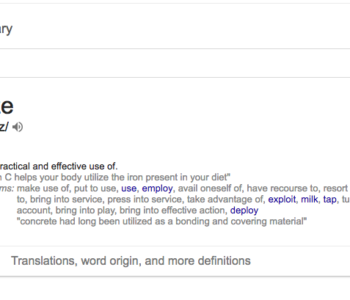 Career
Career
How to Effectively Give and Receive Feedback
Receiving feedback–without getting defensive–takes practice. But just as difficult is giving feedback. Constructive feedback is common in a creative profession. It’s how projects get pushed to the best possible place.
Since feedback is a must for project success, the way we give feedback is critical to getting someone to listen to it–and grow from it.
And it’s not just about receiving feedback from our superiors or giving feedback to our subordinates. The path to the best possible outcomes is creating an environment where giving and receiving feedback from peers, supervisors, and subordinates is encouraged.
Your relationships with each individual–peer, subordinate, superior, client–probably differs slightly. As such, our style may change from one group to another, or we may need to make adjustments based on how individuals communicate and learn best.
The only way to do that is to have a consistent feedback loop in which you build trust and ensure everyone feels safe raising their hand to suggest improvements. Here are a few ways I’ve seen it done well.
Giving Feedback
Address issues immediately
Too often, I’ve seen projects get derailed or frustrations fester because someone waits to give feedback. It’s much easier for someone to understand the issue if you address it as it happens or immediately after it happens. For example, maybe you don’t feel comfortable offering someone direct feedback in a meeting, especially if it’s in front of a slew of people. But, you may pull them aside immediately following the meeting with a, “Hey, can I talk to you for a second?”
I’ve seen clients make the same small edits on writers’ work over again. For example, using the term “clients” instead of “customers.” By telling the writer the first time it happens, you give the writer a chance to learn your style (better yet, create a style guide) and save yourself or your copyeditor from having to make repetitive corrections.
Give a clear path forward
“I’m not sure about this,” is one of the least helpful comments that I often see. It’s right up there with conflicting feedback from multiple stakeholders within the same company. It prompts questions from me like, “Is it the idea you’re not sure of or a particular word(s)? Which feedback do you prefer us to incorporate?” I’ll always give my recommendation, but that prompts another round of edits that could have been resolves sooner.
While you don’t necessarily want to recommend a specific alternative process, idea, or word choice, you do want to provide direction on how the individual can move forward. With copy, I often see people say “something that captures an idea sort of like this,” or similar, high-level feedback so you’re giving the individual freedom to explore alternatives without wasting your time and doing the job you hired the writer to do.
Pointing someone in the general direction can help ensure they don’t come back with copy that has gone in the opposite direction. Of course, if you simply prefer the word “client” to “customer,” then let the person know (and add it to your style guide).
Speak truth
Honesty is hard, but necessary. This doesn’t mean you need to be rude or blunt with your delivery. You can explain what’s working–and what’s not–by focusing on the copy itself and leaving the person out of it. If there’s something that feels off, spend some time thinking about why before trying to put it into words.
If you have a prescriptive change (“change this to this”), it helps to explain why. Your writer, particularly if they may work with you on a future project, can then build on their understanding of your business. While a style guide can capture a lot, it doesn’t always capture the organizational knowledge trapped in employees’ brains.
And, back to the first point, address it as soon as possible. Giving honest feedback late in a project is only going to cause more delays.
Consider the medium
Face-to-face is the best way to give feedback, but sometimes you simply can’t. With so many tools for connecting remotely–FaceTime, Hangouts, Zoom, Bluejeans, Facebook–it’s easy to have a face-to-face discussion even time zones and miles apart. This way, critical body and facial cues aren’t lost.
The next best option: phone. This still gives both sides opportunity to hear the tone in each other’s voices and for quicker back and forth.
The last resort: email. Too often, copywriters toss projects over the fence. I’m guilty of it, too. Sometimes things are moving fast and you need to get it out the door. Having feedback via email or straight in a Word or Google doc is great for a reference. But if possible, you’ll want to hop on a call or video chat to run through that written feedback. Sometimes
Receiving Feedback
Ask for feedback
You don’t have to wait until an annual review to get feedback from a manager or boss. You also don’t have to wait until a project is over for feedback–whether you’re the client or the copywriter. In fact, being proactive can save you a lot of headaches and time. Having a conversation as soon as you have questions or concerns can help you get back on track before going too far off the rails.
As the copywriter, exhaust your other options first. If you can Google information that will help you overcome a challenge do so–even if it means you’ll have to work overtime to learn something new. If you can sleep on something and come back with fresh eyes, do so. Push yourself to grow. But, if you’ve exhausted options and you’re no longer sure if you’re delivering what’s needed, you can ask for initial feedback.
As the client, if the writer hasn’t told you how they prefer to receive feedback, ask. I’ve worked with clients who are working with a creative team for the first time. Asking for feedback on design and copy involves stretching new muscles. And that’s OK–as long as both parties are communicating.
When a project is over, ask about what you did well and what you could improve next time.
Lower the defenses
Constructive feedback can often be taken as negative feedback. Our defense mechanisms go up and we’re resistant. You think: “I can’t believe they don’t get what I was trying to say here!” or “Really? They want to change ‘the’ to ‘an’? Can’t they just accept that they don’t have feedback to give?”
Reframe your mindset. You’re not a failure. This is an opportunity to learn and understand the other party. If it’s your client, do they want something changed for a particular reason? You don’t always know the full corporate history. If it’s your copywriter, ask your writer why they want to make a change. If they’re an expert in their craft (as they should be!), then there’s a reason they chose the word, phrase, or format they did.
No matter what, figure out a plan for moving forward. More often than not, that may include talking through specific choices or points of confusion. There are few things solid communication can’t fix.
Change the medium
If you received feedback via email, you may recommend a call to chat through specifics. A lot of nuance is lost within email, particularly nonverbal language and tone. Talking in person or even on the phone helps both parties remember that the other is human.
Just because you get feedback via one platform doesn’t mean you have to stay on that platform. If you get a text, ask if the person has time for a call. If you have a video chat, ask if you can follow up once you’ve digested the information via another video chat (in this case, email could make sense to have written guidance).
Follow up
Once you have a chance to make adjustments, chat with whomever gave you feedback, and ask if your corrections were effective.
Exactly when you follow up will depend on the situation. If you’ve been given feedback that will take longer to show results, then you may ask in a couple of weeks or months whether the person who gave the feedback noticed any changes.
No matter if you’re giving or receiving feedback (and we all inevitably do both on a daily basis!), take some time to slow down and organize your thoughts. What’s your goal in giving feedback? With this in mind, you can better deliver your feedback with your end goal in mind. If you’re receiving feedback, what do you need to do move forward? Make sure you get it, even if it requires asking the same question several different ways.






